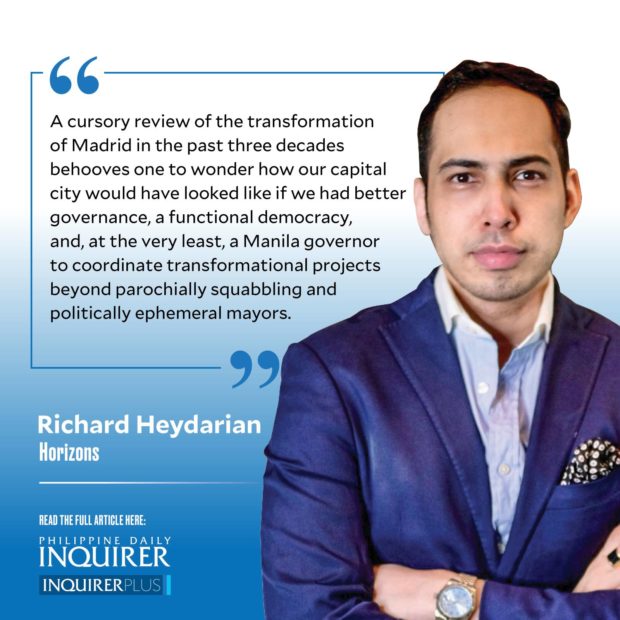The ghost of Rizal
Madrid—On the way back to his hometown, Ibarra, the protagonist of “Noli Me Tángere,” was brimming with romantic optimism. Yet, he was also overwhelmed with a stream of conflicting emotions, including melancholic joy. The road leading out of Manila, then the “Pearl of the Orient Seas” (Perla Del Mar del Oriente), constantly evoked memories of his recent experience overseas.
“The lively conversations and joking [among folks in Manila streets] automatically carried his thoughts back to, among other things, the Lavapiés section of Madrid,” wrote Rizal, accentuating Ibarra’s visceral urge to compare Europe, where his forefathers hailed from, with his native homeland in the Philippines. “The botanical garden drove away these delightful memories and the demon of comparison placed him back in front of the botanical gardens of Europe…”
Rizal’s usage of the term “el demonio de las comparaciones” (demon of comparison) was one of the most poignant phrases in the entire novel that helped spark Asia’s first anti-colonial revolution. The political scientist Benedict Anderson, who alternatively translated the phrase as “specter of comparison,” constantly drew on Rizal’s oeuvre in his unparalleled analysis of anti-colonial struggles and post-colonial tragedies in Southeast Asia.
It goes without saying that the same “demon of comparison” inevitably confronts any historically oriented Filipino visiting contemporary Madrid. The metropolis may not have the avant-garde reputation of Barcelona, where Antoni Gaudí pioneered a whole new architectural genre, nor the medieval grandeur of Toledo, where Spain’s cosmopolitan heritage is on full display.
Madrid is, however, a dynamic, lively city tinged with traces of a once-dominant global empire. Its streets are squeaky clean and utterly welcoming. Its main architectural wonders have been beautifully preserved, with main boulevards rivaling those in Paris in both engineering scale and aesthetic grandeur. The museums are unquestionably majestic, proudly showcasing Spain’s Golden Age (Siglo de Oro) heritage as well as the wonders of modern art.
Not to mention, the never-ending reconstruction projects across the city, including near Plaza Mayor as well as the newly renovated Santiago Bernabéu Stadium, which represents the uber-modern face of Spain.
The Turkish writer Orhan Pamuk famously described his home city of Istanbul, another former imperial capital, as a city of melancholy (“hüzün”). In Madrid, however, what I found was more of nostalgia than melancholy.
Walking along the city’s most glamorous streets, including Calle de Sevilla, where the iconic Four Seasons Hotel is located, one can’t help but wonder if Manila would have looked similar had Americans not bombed out of existence much of the city’s architectural heritage during the twilight days of World War II.
A cursory review of the transformation of Madrid in the past three decades behooves one to wonder how our capital city would have looked like if we had better governance, a functional democracy, and, at the very least, a Manila governor to coordinate transformational projects beyond parochially squabbling and politically ephemeral mayors.
Above all, however, Madrid feels eerily familiar. One can walk the same streets that our “ilustrados” once graced. One can visit the same quarters that hosted Rizal and his compatriots. And one can see, with her own eyes, the world-renowned genius of Juan Luna and Félix Resurrección Hidalgo, who authored one of the greatest artworks of the late-19th century. And in Gran Hotel Inglés, where our ilustrados once celebrated a glorious moment in Philippine history, lurks the ghost of Rizal, who passionately argued that Filipinos can achieve greatness whenever given the opportunity.
Staring at Pablo Picasso’s most haunting work, “Guernica,” which painfully depicts the horror of fascism and civil war, one can’t help but wonder how Spain’s historical trajectory diverged from that of its crown jewel in the East, the Philippines. After all, Spain was a backwater by the beginning of the 20th century. In fact, the country remained a deeply feudalistic, economically stagnant, and politically authoritarian nation until the end of the Cold War.
And yet, the nation managed to shake off many of its maladies—even going so far as exhuming the remains of its former dictator, Francisco Franco—en route to becoming a modern, democratic, and industrialized nation. In Rizal’s home nation, however, cultural heritage is often sacrificed for lopsided development, while liberal republicanism is gasping for survival amid the proliferation of shameless revisionism and authoritarian populism.
—————–
rheydarian@inquirer.com.ph





















